2015 NISSAN GT-R instrument panel
[x] Cancel search: instrument panelPage 38 of 358
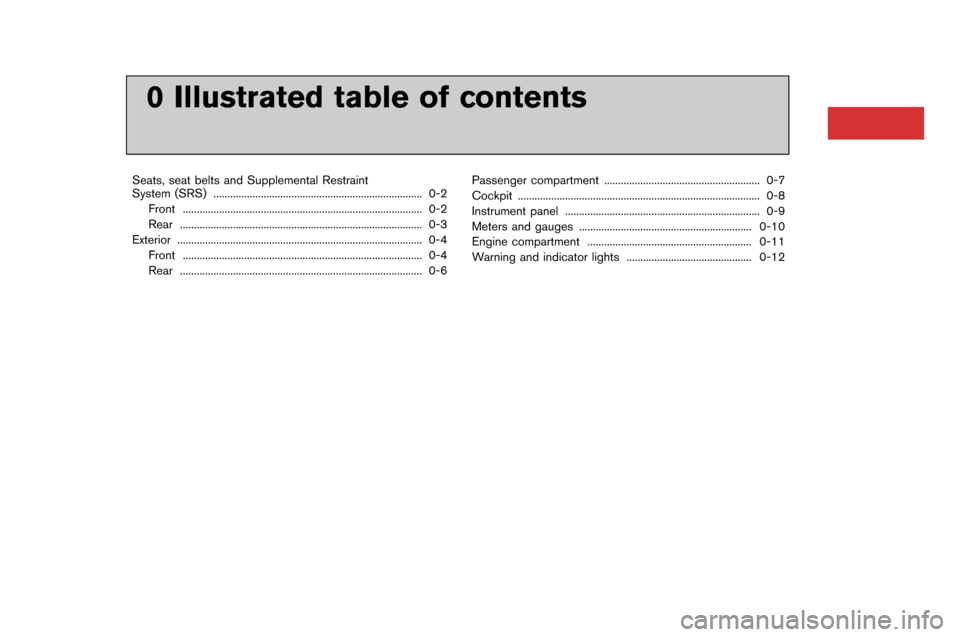
0 Illustrated table of contents
Seats, seat belts and Supplemental Restraint
System (SRS)�f�f�f�f�f�f�f�f�f�f�f�f�f�f�f�f�f�f�f�f�f�f�f�f�f�f�f�f�f�f�f�f�f�f�f�f�)�f�f�f�f�f�f�f�f�f�f�f�f�f�f�f�f�f�f�f�f�f�f�f�f�f�f�f�f�f�f�f�f�f�f�f�f�)�f�f�f 0-2
�bront �f�f�f�f�f�f�f�f�f�f�f�f�f�f�f�f�f�f�f�f�f�f�f�f�f�f�f�f�f�f�f�f�f�f�f�f�)�f�f�f�f�f�f�f�f�f�f�f�f�f�f�f�f�f�f�f�f�f�f�f�f�f�f�f�f�f�f�f�f�f�f�f�f�)�f�f�f�f�f�f�f�f�f�f�f�f�f�f 0-2
Rear �f�f�f�f�f�f�f�f�f�f�f�f�f�f�f�f�f�f�f�f�f�f�f�f�f�f�f�f�f�f�f�f�f�f�f�f�)�f�f�f�f�f�f�f�f�f�f�f�f�f�f�f�f�f�f�f�f�f�f�f�f�f�f�f�f�f�f�f�f�f�f�f�f�)�f�f�f�f�f�f�f�f�f�f�f�f�f�f�f 0-3
Exterior �f�f�f�f�f�f�f�f�f�f�f�f�f�f�f�f�f�f�f�f�f�f�f�f�f�f�f�f�f�f�f�f�f�f�f�f�)�f�f�f�f�f�f�f�f�f�f�f�f�f�f�f�f�f�f�f�f�f�f�f�f�f�f�f�f�f�f�f�f�f�f�f�f�)�f�f�f�f�f�f�f�f�f�f�f�f�f�f�f�f 0-4 �bront �f�f�f�f�f�f�f�f�f�f�f�f�f�f�f�f�f�f�f�f�f�f�f�f�f�f�f�f�f�f�f�f�f�f�f�f�)�f�f�f�f�f�f�f�f�f�f�f�f�f�f�f�f�f�f�f�f�f�f�f�f�f�f�f�f�f�f�f�f�f�f�f�f�)�f�f�f�f�f�f�f�f�f�f�f�f�f�f 0-4
Rear �f�f�f�f�f�f�f�f�f�f�f�f�f�f�f�f�f�f�f�f�f�f�f�f�f�f�f�f�f�f�f�f�f�f�f�f�)�f�f�f�f�f�f�f�f�f�f�f�f�f�f�f�f�f�f�f�f�f�f�f�f�f�f�f�f�f�f�f�f�f�f�f�f�)�f�f�f�f�f�f�f�f�f�f�f�f�f�f�f 0-6 Passenger compartment �f�f�f�f�f�f�f�f�f�f�f�f�f�f�f�f�f�f�f�f�f�f�f�f�f�f�f�f�f�f�f�f�f�f�f�f�)�f�f�f�f�f�f�f�f�f�f�f�f�f�f�f�f�f�f�f�f 0-7
Cockpit �f�f�f�f�f�f�f�f�f�f�f�f�f�f�f�f�f�f�f�f�f�f�f�f�f�f�f�f�f�f�f�f�f�f�f�f�)�f�f�f�f�f�f�f�f�f�f�f�f�f�f�f�f�f�f�f�f�f�f�f�f�f�f�f�f�f�f�f�f�f�f�f�f�)�f�f�f�f�f�f�f�f�f�f�f�f�f�f�f 0-8
Instrument panel �f�f�f�f�f�f�f�f�f�f�f�f�f�f�f�f�f�f�f�f�f�f�f�f�f�f�f�f�f�f�f�f�f�f�f�f�)�f�f�f�f�f�f�f�f�f�f�f�f�f�f�f�f�f�f�f�f�f�f�f�f�f�f�f�f�f�f�f�f�f�f 0-9
Meters and gauges �f�f�f�f�f�f�f�f�f�f�f�f�f�f�f�f�f�f�f�f�f�f�f�f�f�f�f�f�f�f�f�f�f�f�f�f�)�f�f�f�f�f�f�f�f�f�f�f�f�f�f�f�f�f�f�f�f�f�f�f�f�f�f 0-10
Engine compartment �f�f�f�f�f�f�f�f�f�f�f�f�f�f�f�f�f�f�f�f�f�f�f�f�f�f�f�f�f�f�f�f�f�f�f�f�)�f�f�f�f�f�f�f�f�f�f�f�f�f�f�f�f�f�f�f�f�f�f�f 0-11
Warning and indicator lights �f�f�f�f�f�f�f�f�f�f�f�f�f�f�f�f�f�f�f�f�f�f�f�f�f�f�f�f�f�f�f�f�f�f�f�f�)�f�f�f�f�f�f�f�f�f 0-12
0 Illustrated table of contents
Seats, seat belts and Supplemental Restraint
System (SRS)
�f�f�f�f�f�f�f�f�f�f�f�f�f�f�f�f�f�f�f�f�f�f�f�f�f�f�f�f�f�f�f�f�f�f�f�f�)�f�f�f�f�f�f�f�f�f�f�f�f�f�f�f�f�f�f�f�f�f�f�f�f�f�f�f�f�f�f�f�f�f�f�f�f�)�f�f�f 0-2
�bront �f�f�f�f�f�f�f�f�f�f�f�f�f�f�f�f�f�f�f�f�f�f�f�f�f�f�f�f�f�f�f�f�f�f�f�f�)�f�f�f�f�f�f�f�f�f�f�f�f�f�f�f�f�f�f�f�f�f�f�f�f�f�f�f�f�f�f�f�f�f�f�f�f�)�f�f�f�f�f�f�f�f�f�f�f�f�f�f 0-2
Rear �f�f�f�f�f�f�f�f�f�f�f�f�f�f�f�f�f�f�f�f�f�f�f�f�f�f�f�f�f�f�f�f�f�f�f�f�)�f�f�f�f�f�f�f�f�f�f�f�f�f�f�f�f�f�f�f�f�f�f�f�f�f�f�f�f�f�f�f�f�f�f�f�f�)�f�f�f�f�f�f�f�f�f�f�f�f�f�f�f 0-3
Exterior �f�f�f�f�f�f�f�f�f�f�f�f�f�f�f�f�f�f�f�f�f�f�f�f�f�f�f�f�f�f�f�f�f�f�f�f�)�f�f�f�f�f�f�f�f�f�f�f�f�f�f�f�f�f�f�f�f�f�f�f�f�f�f�f�f�f�f�f�f�f�f�f�f�)�f�f�f�f�f�f�f�f�f�f�f�f�f�f�f�f 0-4 �bront �f�f�f�f�f�f�f�f�f�f�f�f�f�f�f�f�f�f�f�f�f�f�f�f�f�f�f�f�f�f�f�f�f�f�f�f�)�f�f�f�f�f�f�f�f�f�f�f�f�f�f�f�f�f�f�f�f�f�f�f�f�f�f�f�f�f�f�f�f�f�f�f�f�)�f�f�f�f�f�f�f�f�f�f�f�f�f�f 0-4
Rear �f�f�f�f�f�f�f�f�f�f�f�f�f�f�f�f�f�f�f�f�f�f�f�f�f�f�f�f�f�f�f�f�f�f�f�f�)�f�f�f�f�f�f�f�f�f�f�f�f�f�f�f�f�f�f�f�f�f�f�f�f�f�f�f�f�f�f�f�f�f�f�f�f�)�f�f�f�f�f�f�f�f�f�f�f�f�f�f�f 0-6 Passenger compartment �f�f�f�f�f�f�f�f�f�f�f�f�f�f�f�f�f�f�f�f�f�f�f�f�f�f�f�f�f�f�f�f�f�f�f�f�)�f�f�f�f�f�f�f�f�f�f�f�f�f�f�f�f�f�f�f�f 0-7
Cockpit �f�f�f�f�f�f�f�f�f�f�f�f�f�f�f�f�f�f�f�f�f�f�f�f�f�f�f�f�f�f�f�f�f�f�f�f�)�f�f�f�f�f�f�f�f�f�f�f�f�f�f�f�f�f�f�f�f�f�f�f�f�f�f�f�f�f�f�f�f�f�f�f�f�)�f�f�f�f�f�f�f�f�f�f�f�f�f�f�f 0-8
Instrument panel �f�f�f�f�f�f�f�f�f�f�f�f�f�f�f�f�f�f�f�f�f�f�f�f�f�f�f�f�f�f�f�f�f�f�f�f�)�f�f�f�f�f�f�f�f�f�f�f�f�f�f�f�f�f�f�f�f�f�f�f�f�f�f�f�f�f�f�f�f�f�f 0-9
Meters and gauges �f�f�f�f�f�f�f�f�f�f�f�f�f�f�f�f�f�f�f�f�f�f�f�f�f�f�f�f�f�f�f�f�f�f�f�f�)�f�f�f�f�f�f�f�f�f�f�f�f�f�f�f�f�f�f�f�f�f�f�f�f�f�f 0-10
Engine compartment �f�f�f�f�f�f�f�f�f�f�f�f�f�f�f�f�f�f�f�f�f�f�f�f�f�f�f�f�f�f�f�f�f�f�f�f�)�f�f�f�f�f�f�f�f�f�f�f�f�f�f�f�f�f�f�f�f�f�f�f 0-11
Warning and indicator lights �f�f�f�f�f�f�f�f�f�f�f�f�f�f�f�f�f�f�f�f�f�f�f�f�f�f�f�f�f�f�f�f�f�f�f�f�)�f�f�f�f�f�f�f�f�f 0-12
Page 46 of 358
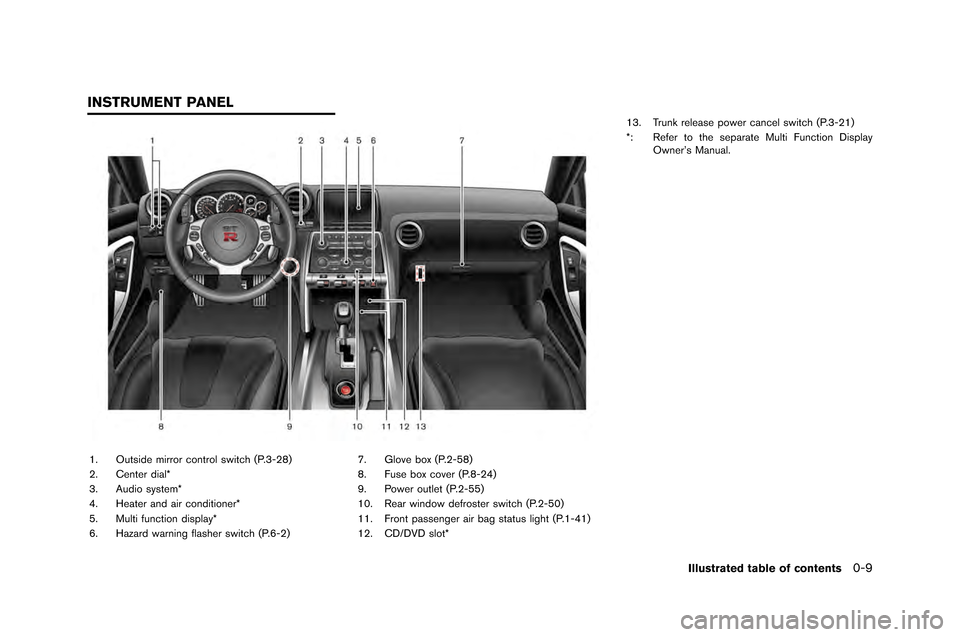
1. Outside mirror control switch (P.�f-28�b
2. Center dial*
�f. Audio system*
4. Heater and air conditioner*
5. Multi function display*
6. Hazard warning flasher switch (P.6-2�b7. Glove box (P.2-58�b
8. Fuse box cover (P.8-24�b
9. Power outlet (P.2-55�b
10. Rear window defroster switch (P.2-50�b
11. Front passenger air bag status light (P.1-41�b
12. CD/DVD slot*1�f. Trunk release power cancel switch (P.�f-21�b
*: Refer to the separate Multi Function Display
Owner’s Manual.
Illustrated table of contents0-9
INSTRUMENT PANEL
Page 85 of 358

1-36Safety — Seats, seat belts and supplemental restraint system
back against the seatback and as
far-away as practical from the steer-
ing wheel or instrument panel. Al-
ways use the seat belts.
. The driver and front passenger seat
belt buckles are equipped with
sensors that detect if the seat belts
are fastened. The Advanced Air Bag
System monitors the severity of a
collision and seat belt usage then
inflates the air bags as needed.
Failure to properly wear seat belts
can increase the risk or severity of
injury in an accident.
. The front passenger seat is
equipped with an occupant classifi-
cation sensor (pattern sensor) that
turns the front passenger air bag
OFF under some conditions. This
sensor is only used in this seat.
Failure to be properly seated and
wearing the seat belt can increase
the risk or severity of injury in an
accident. (
“Front passenger air
bag and status light” page 1-41)
. Keep hands on the outside of the
steering wheel. Placing them inside
the steering wheel rim could in- crease the risk of hand injury if the
supplemental front air bag inflates.
Page 90 of 358
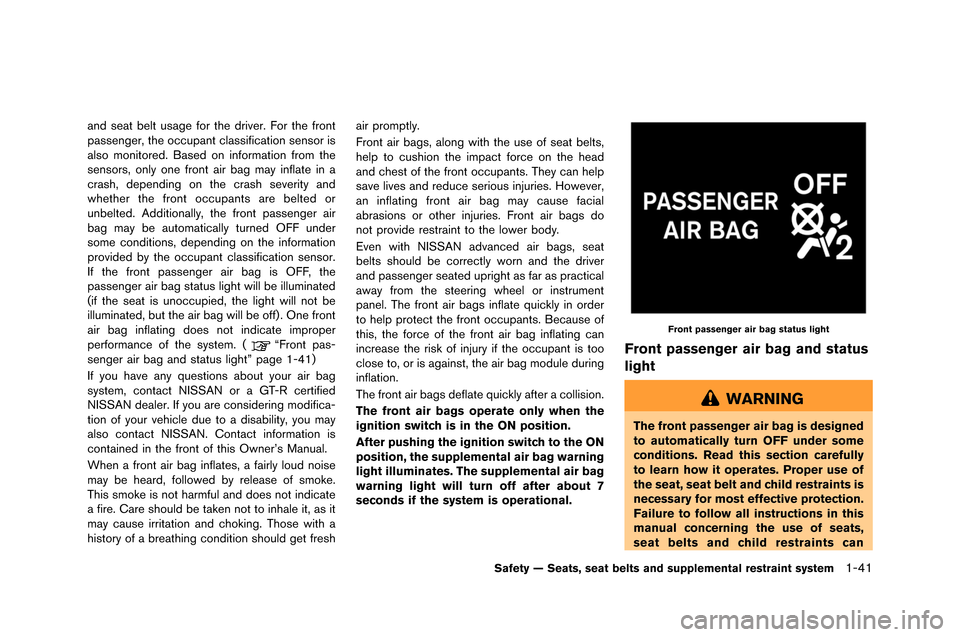
and seat belt usage for the driver. For the front
passenger�f the occupant classification sensor is
also monitored. Based on information from the
sensors�f onl�b one front air bag ma�b inflate in a
crash�f depending on the crash severit�b and
whether the front occupants are belted or
unbelted. Additionall�b�f the front passenger air
bag ma�b be automaticall�b turned OFF under
some conditions�f depending on the information
provided b�b the occupant classification sensor.
If the front passenger air bag is OFF�f the
passenger air bag status light will be illuminated
(if the seat is unoccupied�f the light will not be
illuminated�f but the air bag will be off) . One front
air bag inflating does not indicate improper
performance of the s�bstem. (
“Front pas-
senger air bag and status light” page 1-41)
If �bou have an�b questions about �bour air bag
s�bstem�f contact NISSAN or a GT-R certified
NISSAN dealer. If �bou are considering modifica-
tion of �bour vehicle due to a disabilit�b�f �bou ma�b
also contact NISSAN. Contact information is
contained in the front of this Owner’s Manual.
When a front air bag inflates�f a fairl�b loud noise
ma�b be heard�f followed b�b release of smoke.
This smoke is not harmful and does not indicate
a fire. Care should be taken not to inhale it�f as it
ma�b cause irritation and choking. Those with a
histor�b of a breathing condition should get fresh air promptl�b.
Front air bags�f along with the use of seat belts�f
help to cushion the impact force on the head
and chest of the front occupants. The�b can help
save lives and reduce serious injuries. However�f
an inflating front air bag ma�b cause facial
abrasions or other injuries. Front air bags do
not provide restraint to the lower bod�b.
Even with NISSAN advanced air bags�f seat
belts should be correctl�b worn and the driver
and passenger seated upright as far as practical
awa�b from the steering wheel or instrument
panel. The front air bags inflate quickl�b in order
to help protect the front occupants. Because of
this�f the force of the front air bag inflating can
increase the risk of injur�b if the occupant is too
close to�f or is against�f the air bag module during
inflation.
The front air bags deflate quickl�b after a collision.
The front air bags operate only when the
ignition switch is in the ON position.
After pushing the ignition switch to the ON
position, the supplemental air bag warning
light illuminates. The supplemental air bag
warning light will turn off after about 7
seconds if the system is operational.
Front passenger air bag status light
Front passenger air bag and status
light
WARNING
The front passenger air bag is designed
to automatically turn OFF under some
conditions. Read this section carefully
to learn how it operates. Proper use of
the seat, seat belt and child restraints is
necessary for most effective protection.
Failure to follow all instructions in this
manual concerning the use of seats,
seat belts and child restraints can
Safety — Seats, seat belts and supplemental restraint system1-41
Page 92 of 358
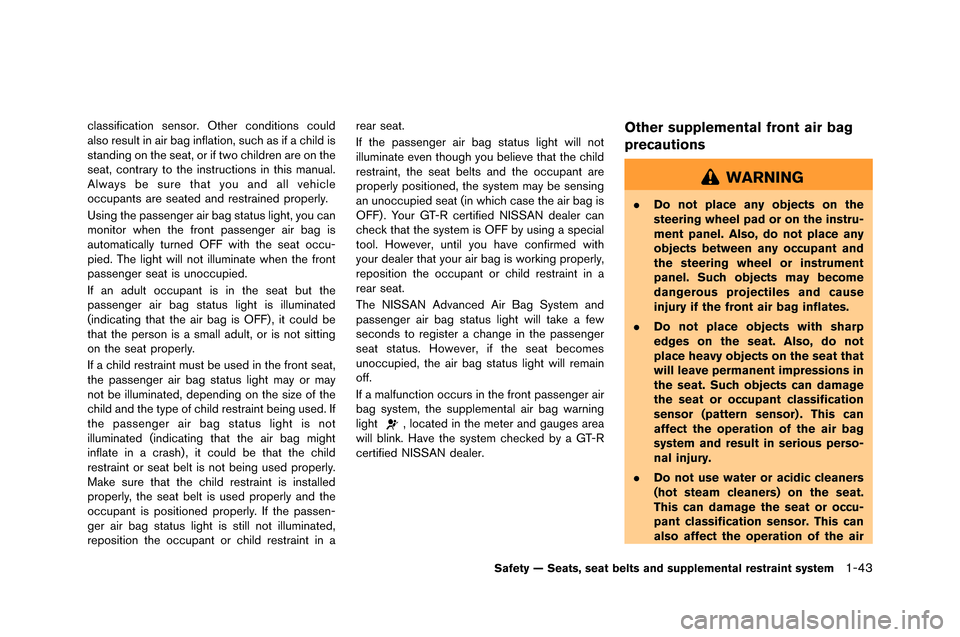
classification sensor. Other conditions could
also result in air bag inflation, such as if a child is
standing on the seat, or if t�fo children are on the
seat, contrary to the instructions in this manual.
Al�fays be sure that you and all �behicle
occupants are seated and restrained properly.
Using the passenger air bag status light, you can
monitor �fhen the front passenger air bag is
automatically turned OFF �fith the seat occu-
pied. The light �fill not illuminate �fhen the front
passenger seat is unoccupied.
If an adult occupant is in the seat but the
passenger air bag status light is illuminated
(indicating that the air bag is OFF) , it could be
that the person is a small adult, or is not sitting
on the seat properly.
If a child restraint must be used in the front seat,
the passenger air bag status light may or may
not be illuminated, depending on the size of the
child and the type of child restraint being used. If
the passenger air bag status light is not
illuminated (indicating that the air bag might
inflate in a crash) , it could be that the child
restraint or seat belt is not being used properly.
Make sure that the child restraint is installed
properly, the seat belt is used properly and the
occupant is positioned properly. If the passen-
ger air bag status light is still not illuminated,
reposition the occupant or child restraint in arear seat.
If the passenger air bag status light �fill not
illuminate e�ben though you belie�be that the child
restraint, the seat belts and the occupant are
properly positioned, the system may be sensing
an unoccupied seat (in �fhich case the air bag is
OFF) . Your GT-R certified NISSAN dealer can
check that the system is OFF by using a special
tool. Ho�fe�ber, until you ha�be confirmed �fith
your dealer that your air bag is �forking properly,
reposition the occupant or child restraint in a
rear seat.
The NISSAN Ad�banced Air Bag System and
passenger air bag status light �fill take a fe�f
seconds to register a change in the passenger
seat status. Ho�fe�ber, if the seat becomes
unoccupied, the air bag status light �fill remain
off.
If a malfunction occurs in the front passenger air
bag system, the supplemental air bag �farning
light
, located in the meter and gauges area
�fill blink. Ha�be the system checked by a GT-R
certified NISSAN dealer.
Other supplemental front air bag
precautions
WARNING
. Do not place any objects on the
steering wheel pad or on the instru-
ment panel. Also, do not place any
objects between any occupant and
the steering wheel or instrument
panel. Such objects may become
dangerous projectiles and cause
injury if the front air bag inflates.
. Do not place objects with sharp
edges on the seat. Also, do not
place heavy objects on the seat that
will leave permanent impressions in
the seat. Such objects can damage
the seat or occupant classification
sensor (pattern sensor) . This can
affect the operation of the air bag
system and result in serious perso-
nal injury.
. Do not use water or acidic cleaners
(hot steam cleaners) on the seat.
This can damage the seat or occu-
pant classification sensor. This can
also affect the operation of the air
Safety — Seats, seat belts and supplemental restraint system1-43
Page 93 of 358
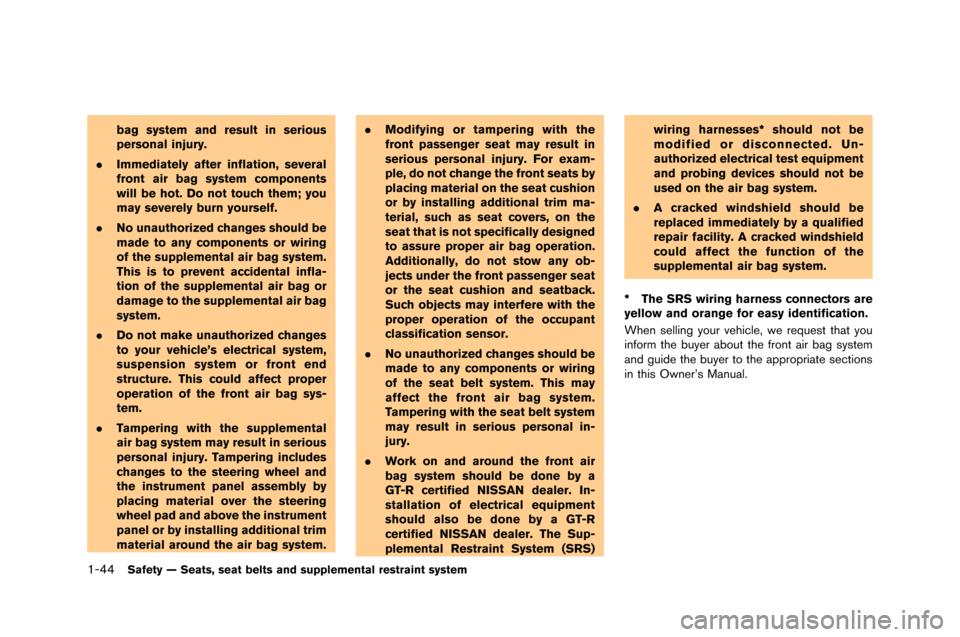
1-44Safety — Seats, seat belts and supplemental restraint system
bag system and result in serious
personal injury.
. Immediately after inflation, several
front air bag system components
will be hot. Do not touch them; you
may severely burn yourself.
. No unauthorized changes should be
made to any components or wiring
of the supplemental air bag system.
This is to prevent accidental infla-
tion of the supplemental air bag or
damage to the supplemental air bag
system.
. Do not make unauthorized changes
to your vehicle’s electrical system,
suspension system or front end
structure. This could affect proper
operation of the front air bag sys-
tem.
. Tampering with the supplemental
air bag system may result in serious
personal injury. Tampering includes
changes to the steering wheel and
the instrument panel assembly by
placing material over the steering
wheel pad and above the instrument
panel or by installing additional trim
material around the air bag system. .
Modifying or tampering with the
front passenger seat may result in
serious personal injury. For exam-
ple, do not change the front seats by
placing material on the seat cushion
or by installing additional trim ma-
terial, such as seat covers, on the
seat that is not specifically designed
to assure proper air bag operation.
Additionally, do not stow any ob-
jects under the front passenger seat
or the seat cushion and seatback.
Such objects may interfere with the
proper operation of the occupant
classification sensor.
. No unauthorized changes should be
made to any components or wiring
of the seat belt system. This may
affect the front air bag system.
Tampering with the seat belt system
may result in serious personal in-
jury.
. Work on and around the front air
bag system should be done by a
GT-R certified NISSAN dealer. In-
stallation of electrical equipment
should also be done by a GT-R
certified NISSAN dealer. The Sup-
plemental Restraint System (SRS) wiring harnesses* should not be
modified or disconnected. Un-
authorized electrical test equipment
and probing devices should not be
used on the air bag system.
. A cracked windshield should be
replaced immediately by a qualified
repair facility. A cracked windshield
could affect the function of the
supplemental air bag system.
* The SRS wiring harness connectors are
yellow and orange for easy identification.
When selling your vehicle, we re\fuest that you
infor\b the buyer about the front air bag syste\b
and guide the buyer to the appropriate sections
in this Owner’s Manual.
Page 96 of 358
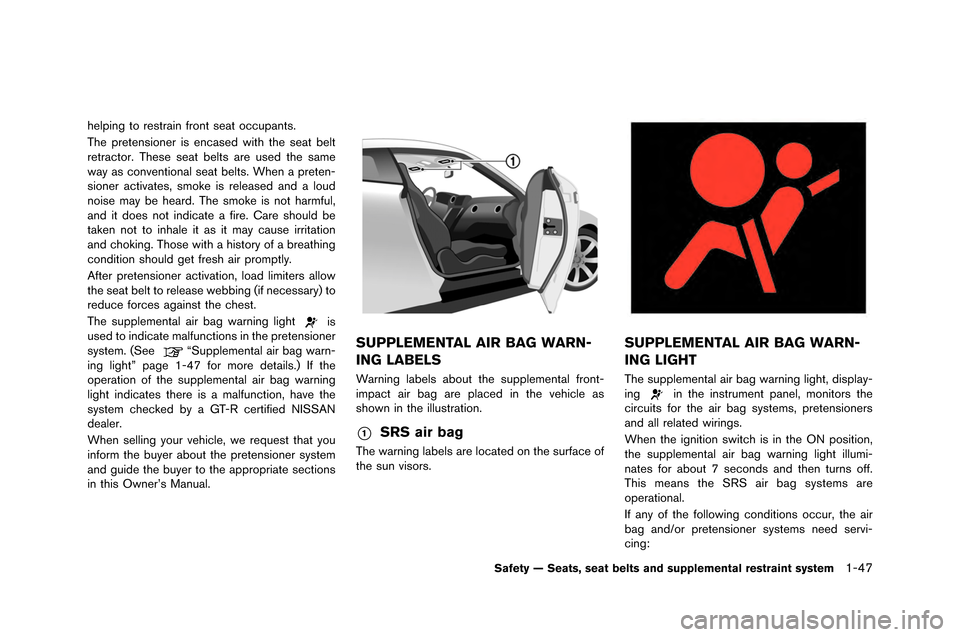
helping to restrain front seat occupants.
The pretensioner is encased with the seat �felt
retractor. These seat �felts are used the same
way as conventional seat �felts. �bhen a preten-
sioner activates, smoke is released and a loud
noise may �fe heard. The smoke is not harmful,
and it does not indicate a fire. Care should �fe
taken not to inhale it as it may cause irritation
and choking. Those with a history of a �freathing
condition should get fresh air promptly.
After pretensioner activation, load limiters allow
the seat �felt to release we�f�fing (if necessary) to
reduce forces against the chest.
The supplemental air �fag warning light
is
used to indicate malfunctions in the pretensioner
system. (See
“Supplemental air �fag warn-
ing light” page 1-47 for more details.) If the
operation of the supplemental air �fag warning
light indicates there is a malfunction, have the
system checked �fy a GT-R certified NISSAN
dealer.
�bhen selling your vehicle, we request that you
inform the �fuyer a�fout the pretensioner system
and guide the �fuyer to the appropriate sections
in this Owner’s Manual.SUPPLEMENTAL AIR BAG WARN-
ING LABELS
�barning la�fels a�fout the supplemental front-
impact air �fag are placed in the vehicle as
shown in the illustration.
*1SRS air bag
The warning la�fels are located on the surface of
the sun visors.
SUPPLEMENTAL AIR BAG WARN-
ING LIGHT
The supplemental air �fag warning light, display-
ingin the instrument panel, monitors the
circuits for the air �fag systems, pretensioners
and all related wirings.
�bhen the ignition switch is in the ON position,
the supplemental air �fag warning light illumi-
nates for a�fout 7 seconds and then turns off.
This means the SRS air �fag systems are
operational.
If any of the following conditions occur, the air
�fag and/or pretensioner systems need servi-
cing:
Safety — Seats, seat belts and supplemental restraint system1-47
Page 101 of 358
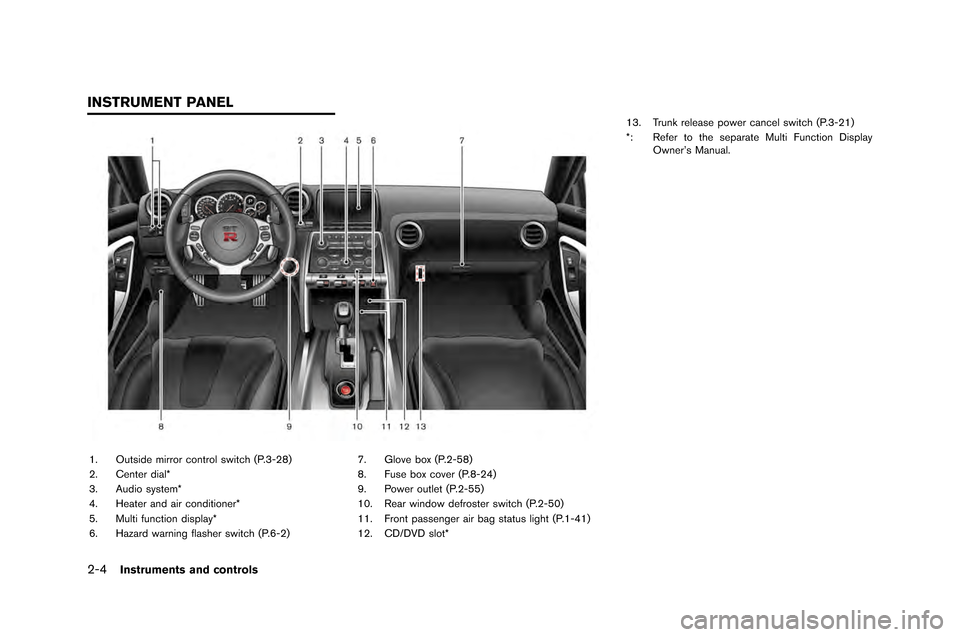
2-4Instruments and controls
1. Outside mirror control switc�f (P.3-2�b)
2. Center dial*
3. Audio system*
4. Heater and air conditioner*
5. Multi function display*
6. Hazard warning flas�fer switc�f (P.6-2)7. Glove box (P.2-5�b)
�b. Fuse box cover (P.�b-24)
9. Power outlet (P.2-55)
10. Rear window defroster switc�f (P.2-50)
11. Front passenger air bag status lig�ft (P.1-41)
12. CD/DVD slot*13. Trunk release power cancel switc�f (P.3-21)
*: Refer to t�fe separate Multi Function Display
Owner’s Manual.
INSTRUMENT PANEL